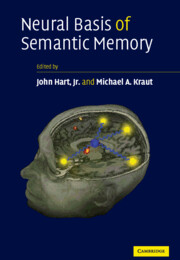Book contents
- Frontmatter
- Contents
- List of contributors
- Preface
- Part I Semantic Memory: Building Models from Lesions
- Part II Insights from Electrophysiology
- Part III Applications of Models to Understanding Cognitive Dysfunction
- Part IV Representations of Nouns and Verbs vs. Objects and Actions
- 6 Effects of word imageability on semantic access: neuroimaging studies
- 7 The neural systems processing tool and action semantics
- 8 The semantic representation of nouns and verbs
- Part V Critical Role of Subcortical Nuclei in Semantic Functions
- Part VI Conceptual Models of Semantics
- Index
- References
6 - Effects of word imageability on semantic access: neuroimaging studies
from Part IV - Representations of Nouns and Verbs vs. Objects and Actions
Published online by Cambridge University Press: 14 September 2009
- Frontmatter
- Contents
- List of contributors
- Preface
- Part I Semantic Memory: Building Models from Lesions
- Part II Insights from Electrophysiology
- Part III Applications of Models to Understanding Cognitive Dysfunction
- Part IV Representations of Nouns and Verbs vs. Objects and Actions
- 6 Effects of word imageability on semantic access: neuroimaging studies
- 7 The neural systems processing tool and action semantics
- 8 The semantic representation of nouns and verbs
- Part V Critical Role of Subcortical Nuclei in Semantic Functions
- Part VI Conceptual Models of Semantics
- Index
- References
Summary
The axiom that conceptual knowledge is grounded in perceptual experience has a long history in philosophy (Locke, 1690/1959; Hume, 1739/1975) and clinical neurology (Wernicke, 1874; Freud, 1891/1953; Geschwind, 1965), and has had considerable influence on modern neuroscience (e.g. Paivio, 1971; Allport, 1985; Damasio, 1989; Barsalou, 1999; Pulvermüller, 1999; Glenberg & Robertson, 2000; Martin et al., 2000). This principle has been applied conspicuously, for example, in accounts of category-related knowledge deficits that postulate selective damage to modality-specific perceptual knowledge stores. Living things tend to have many salient, defining visual features, making access to these concepts highly reliant on knowledge about visual attributes. Conversely, tools and many other artifact concepts are distinguished on the basis of their functions, which could be partly encoded in motor programs and knowledge of the characteristic motion of artifacts (Warrington & McCarthy, 1987; Farah & McClelland, 1991; Martin et al., 2000). Implicit in this account is the notion that conceptual knowledge is partially stored in perceptual and kinesthetic representations residing in or near the modality-specific sensory–motor systems through which these concrete object concepts were originally learned.
While many neuroimaging studies have tested this theory using comparisons between different types of concrete objects (see Martin & Chao, 2001; Bookheimer, 2002; Devlin et al., 2002; Price & Friston, 2002; Thompson-Schill, 2003; Damasio et al., 2004 for excellent reviews), another testable prediction of the theory involves the qualitative distinction between concrete and abstract concepts.
Keywords
- Type
- Chapter
- Information
- Neural Basis of Semantic Memory , pp. 149 - 181Publisher: Cambridge University PressPrint publication year: 2007
References
- 15
- Cited by



